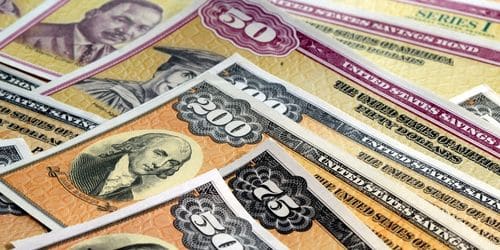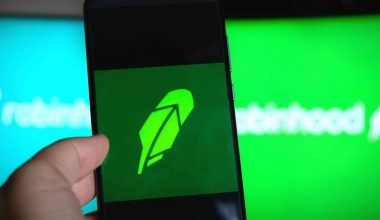Federal Series I savings bonds have been in high demand because they protect against inflation and have a nearly risk-free annual return of 9.62% through October. Financial advisors say it’s difficult to buy I bonds through Treasury Direct, a 20-year-old platform run by the US Department of the Treasury.
What are I Bonds?
I bonds, also referred to as Series I savings bonds are a type of bond that pays interest based on changes in the Consumer Price Index for All Urban Consumers, or CPI-U.
The rate on an I bond combines two rates: a fixed rate and an inflation rate. The fixed interest rate remains constant throughout the life of the bond. Its inflation rate is announced by the Bureau of the Fiscal Service and can change twice a year, in May and November.
The combination of an I bond’s fixed rate and inflation rate creates its composite rate. This is the actual interest rate on an I bond. I bonds are currently offering a composite rate of 6.89% until April 30, 2023.
As its name implies, the inflation rate of an I bond is heavily influenced by inflation. As inflation changes, the inflation rate adjusts to compensate. This can help to preserve the purchasing power of your money. You must also hold your bond for at least a year before cashing it in, and there are interest rate penalties for cashing in before five years.
Is Investing in Bonds a Smart Move?
Depending on your financial objectives and time frame, I bonds may be a good option for you. I bonds can be a safe short-term savings vehicle, especially during inflationary times.
I bonds provide benefits such as the security of being backed by the United States government’s full faith and credit, state and local tax exemptions, and federal tax exemptions when used to fund educational expenses. However, there are penalties for withdrawing funds too quickly, and interest rates are adjusted every six months.
Because I bonds are held for a year or more, they should only be purchased after you have established an adequate emergency fund.
The Demand for I Bonds is Rising Due to Inflation
Bond interest is divided into two components: a fixed rate and a variable rate that adjusts every six months based on the Consumer Price Index, a key measure of inflation. According to a Treasury official, 1.85 million new savings bond accounts have been opened since the annual rate increased to 7.12% in November.
“We’re committed to ensuring that TreasuryDirect users have a positive customer experience,” a Treasury spokesperson said, citing recent changes such as shifted resources and hiring.
“We are also working on an updated, modern replacement for the current Treasury Direct system,” they added.
How to Buy I Bonds from Treasury Direct
To buy I bonds from Treasury Direct, there are two options: new and used.
Buying from the US Treasury
Using the Treasury Direct website or your income tax refund, you can buy I Bonds directly from the U.S. government.
How to Buy I Bonds Through Treasury Direct
- Navigate to TreasuryDirect.gov and click “Open an Account.” To finish your registration, simply follow the instructions.
- After applying for an account, watch for an email from Treasury Direct with your new account number. The term “ecosystem” refers to a group of people who work in the construction industry. Log in with your account number.
- You’ll receive a one-time passcode in your email that you need to enter on the TreasuryDirect screen in the box labeled “OTP.” To access your account, click “Submit.”
- After logging in, click the “BuyDirect” button in the account banner. Select “Series I” and fill out the registration information.
- Indicate your desired I bond purchase amount (any amount between $25 and $10,000), your bank account information, and the date you want to buy the bonds. (Recurring purchases can be scheduled regularly, such as weekly, or on your dates.) Click “Submit.”
- You will have one final opportunity to review your purchase before submitting it and completing the order. Your Treasury Direct account allows you to track and manage your bonds at any time.
Buying through a broker or bank
Treasury securities can also be purchased through a financial institution such as a brokerage or bank. It’s probably the simplest method because the broker will monitor US Treasury Department auctions and place your bid on your behalf. You may, however, be charged a fee to place the bid, depending on the institution.
Only new issues are available through the auctions and TreasuryDirect. So, if you want to buy an older T-bill, note, or bond, you must do so on the secondary market (the major stock exchanges). You must purchase through a brokerage or financial services company, or an online trading platform. There may be a commission charge.
To buy a Treasury bond mutual fund or exchange-traded fund, you’ll also need a brokerage or investment company (ETF). The main advantage of choosing a fund over the securities themselves is that fund shares can be purchased for a fraction of the price of the bonds. And, of course, these funds, which invest in a variety of T-bills, notes, and bonds, provide immediate diversification for the income portion of your portfolio.
Read Also: HOW TO BUY I BONDS SCHWAB: Step-by-Step Guide 2023
How to Buy Treasury I Bonds With Your Federal Income Tax Return
- Fill out Form 8888, Allocation of Refund, to use all or part of your federal income tax refund to purchase I bonds (Including Savings Bond Purchases). When filing your return, follow the instructions on the form.
- Your savings bond will be mailed to you after the IRS processes your tax return.
Read Also: Investing For Beginners Books: 12 Great Options for 2023
What to Think About Before Buying I Bonds Through Treasury Direct
#1. Liquidity
The maturity date of the Treasuries in which you invest determines how liquid (easy to sell) your investment is. Treasury bills with maturities of one year or less are the most liquid option, while 30-year bonds provide the least liquidity.
That said, within the investment universe, Treasuries are pretty liquid animals: There’s always a market for US government bonds. As a result, you can always sell them quickly, though, as previously stated, the exact price they’ll fetch is determined by their coupon rate in comparison to current interest rates.
#2. Risk vs. return
Treasuries have a very low risk, but no investment is completely risk-free. Because these securities are backed by the US government, there is almost no chance that you will not see a return on your investment. Despite ongoing concerns about the budget and deficits, the United States has never defaulted on an obligation in its history.
Keeping this in mind, because there is less risk involved, the return is often not as high as with other income-oriented securities. To compensate for the additional risks associated with the longer maturity, the 30-year T-bond will typically pay a higher interest rate than shorter T-notes.
#3. Taxation
While you must pay federal income tax on them, the interest on Treasuries is exempt from state and local taxes. This can be advantageous for investors living in high-tax jurisdictions.
You only pay taxes on the interest that your T-bonds earn. When your bond matures, you owe nothing because it is simply the repayment of your own money. However, if you sell a bond before it matures, it counts as a capital gain or loss, depending on whether or not you make a profit.
Should You Buy I Bonds Through Treasury Direct?
The closest thing to a risk-free investment is a set of Treasury bonds, T-bills, and T-notes. Because of their dependability, they are ideal for older investors who rely on investment income or for highly conservative investors who never want to risk their principal.
Treasuries typically do not play as large a role as younger investors because they do not provide growth or the most enticing returns. Nonetheless, they can be a great way to diversify anyone’s financial holdings—balancing out that highly speculative stock, for example. They can effectively reduce the overall risk of your portfolio by being incorporated into the asset mix.
Read Also: HOW TO BUY I BONDS ON FIDELITY: Best 2023 Guide
Benefits of Investing in Series I Bonds
- Protect against inflation: By matching the inflation rate with the interest yield, inflation-linked savings bonds protect your money from the eroding effects of inflation.
- Less risk: Series I bonds may be better suited for investors who are nearing retirement, are risk-averse or need to balance their more volatile assets for a diverse investment portfolio. They are issued and backed by the U.S. Department of the Treasury and are virtually risk-free. While the semiannual interest rate may fluctuate in either direction depending on inflation, a Series I bond cannot lose money.
- Tax benefits: The interest you earn on your Series I bonds is exempt from state and local taxes. It is still subject to federal taxes, but you will not have to pay any until the bonds are redeemed. Furthermore, if you use the interest from your bond to pay for qualified college tuition and fees, you can claim an exemption and pay no taxes on the earnings.
Cons of Investing in Series I Bonds
- Lack of Flexibility: Treasury I Bonds are a long-term investment vehicle that requires you to keep your money deposited for at least five years to reap the full benefits. Avoid tying up money you might need soon, such as an emergency fund, in Series I bonds because you can’t usually withdraw your money in the first year. Look into short-term investment options if you want to make a smaller commitment.
- Modest return: Series I bonds are a conservative investment. Their current rate of return, 7.12%, is impressive given their low risk, but it is also historically high. When inflation levels off, that earnings rate is bound to suffer. I bonds are unlikely to outperform more volatile investments such as stocks, which have an annual return of 10.3% on average, according to Vanguard data, even with record-high earnings. They may, however, outperform other comparable risk savings vehicles, such as savings accounts and certificates of deposit.
- Maximum purchase: While I bonds may be the ideal vehicle for shielding your savings from inflation, you can only buy a maximum of $15,000 in electronic and paper bonds per calendar year. To maximize your investment returns, you’ll need a diverse set of investment strategies.
Can I buy Treasury I bonds from my bank?
Yes. Treasury securities can be purchased by individuals, organizations, fiduciaries, and corporate investors through a bank, broker, or dealer.
Is a Treasury I bond A Good investment?
Yes. I bonds can make good short-term investments, but you should feel comfortable holding them for at least one year and, ideally, five years before cashing them in. They may be a good option for seniors who want to earn interest on their savings while also protecting their nest egg.
What is the downside of Treasury I bonds?
I bonds do have some disadvantages, such as the fact that they cannot be redeemed for one year after purchase and their early redemption penalties. If you redeem your I bond within five years of purchase, you will forfeit the bond’s last three months of interest.
Do I need a TreasuryDirect account to buy I bonds?
It depends. You must have a TreasuryDirect account to purchase electronic I bonds. With your IRS tax refund, you can buy paper I bonds.
Can I buy I bonds in my retirement account?
Unfortunately, I Bonds cannot be purchased in an IRA or any other tax-advantaged account. To purchase I Bonds, you must use any available cash or your tax refund.
Conclusion
Series I savings bonds are a low-risk savings vehicle designed to preserve your savings’ value against inflation. They may be suitable for you if you are risk-averse or approaching retirement, and they are also an excellent way to diversify your portfolio with a low-risk investment vehicle. However, they are not suitable for all investors. Contact a financial advisor for assistance managing your savings or investing your money.
Related Articles
- HOW TO BUY TREASURY BONDS: What You Should Know & Guide
- Cash Management Software and Solutions For Businesses
- TOP TREASURY MANAGEMENT SYSTEMS PROVIDERS IN 2023
- Best Fixed Income Investment in 2023
- HOW TO INVEST IN BONDS: Guide & What You Should Know






